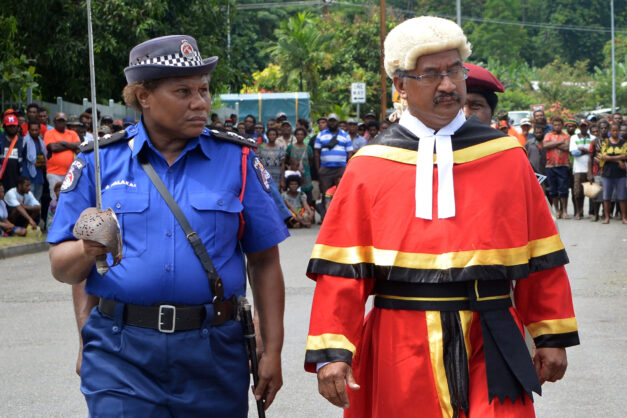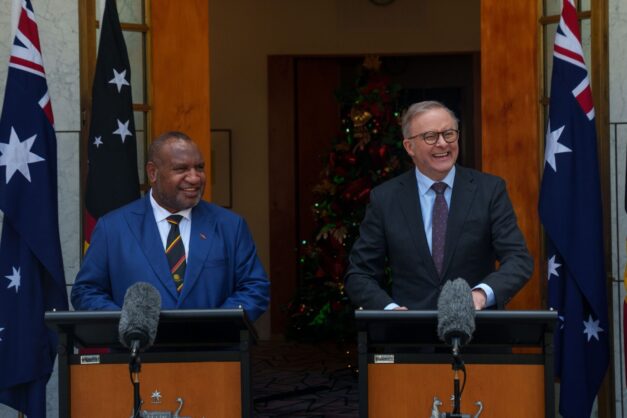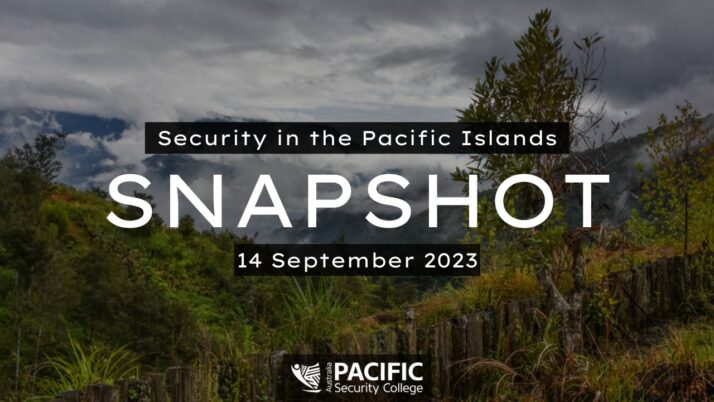The gender agenda in Pacific policing: Moving beyond lip service

Elizabeth Vuvu/AFP
Despite greater rhetorical support for women’s role in Pacific policing, institutional resistance has proven to be a major roadblock, Danielle Watson and Loene Howes write.
Across the Pacific Island region, there is a celebratory tone whenever women ascend the political ranks. Both regionally and internationally, such ascension is recognised as a praiseworthy accomplishment, publicised and presented as a shining beacon to women and girls with ambitions and aspirations beyond conservative gender assignations.
Most recently, the spotlight has been cast on the Honourable Fiame Naomi Mataafa, Samoa’s first female prime minister and the second female head of state to have served in the Pacific; the first was President Hilda Heine of the Republic of Marshall Islands. Attesting to the challenges that these prominent women have overcome, international comparisons reveal very low levels of Pacific women’s participation in the political sphere. These facts indicate how far Pacific Island countries (PICs) are from realising their gender equality goals.
In principle, PICs have expressed continued commitment to improving the circumstances for women and girls, as evidenced in gender equality declarations, revised legislature, memorandums, and policies. In reality, attempts to increase representation of women in the political sphere and advance the gender equality agenda in the public and private sectors have had limited success.
Police forces, as highly visible, male-dominated public organisations, are an interesting case study through which to examine the challenges of advancing the gender equality agenda.
For the top police leaders across the region, all of whom are men, gender continues to be a topical issue. Its prominence is often driven by external requirements for gender representation from governments and international donors and/or partners. Discussions have focused on increasing the number of female officers and enhancing representation at all ranks.
In order to achieve this, there is a need to improve working conditions for female officers and provide equitable opportunities for the women in these services. Insights from police officers and community members across the region, however, reflect mixed sentiments on the authenticity and practicality of gender balancing initiatives.
To date, no female officer has permanently held the position of ‘top cop’ in a PIC. In 2020, the region looked on with interest as Deputy Commissioner Juanita Matanga was poised to take the reins in the Royal Solomon Islands Police Force (RSPIF). She would have been the first woman in the region to do so. However, this highly anticipated promotion did not materialise. Instead, the current RSIPF Commissioner, Mostyn Mangau, who had been promoted from Assistant Commissioner to Deputy Commissioner in 2019, moved up to the Commissioner role within just nine months.
At the Pacific Islands Chiefs of Police Women’s Advisory Network meeting in August 2020, it was observed that for gender strategies to be successful they require strong support from the men in positions of power. Yet dialogue with officers across the region highlighted the wariness of gender initiatives among these men. For example, some officers allude to a perception of non-merit-based or tokenistic appointments of female officers to satisfy external requirements for gender representation.
The success of gender strategies also requires continuity and contingency measures. Police organisations across the region have had a series of well-intentioned gender initiatives such as gender quotas and 50/50 recruitment, with notably less emphasis on retention, organisational placement, or gender integration roadmaps. Such gender balancing initiatives have been described as creating the ‘problem’ of staka woman tumas (‘too much women’) too quickly and without consideration of the impact on daily policing operations.
Some police leaders also describe female frontline officers as an operational hindrance. This reflects an organisational perception that women are physically vulnerable and may not be able to adequately support their male counterparts.
Recent research on public perceptions suggest that women are not viewed as being suited to respond to all calls for service. Male and female officers expressed similar views about the higher likelihood of female officers experiencing difficulties in apprehending male suspects and offenders.
This issue arises due to embedded cultural norms and local ideologies about roles and interactions at the gender interface as well as perceptions of police work. Community members did not report a preference by gender for police officers in response to general calls for service, but a preference for male officers was clear in cases involving a perceived need for the use of physical force. There are other times when women police officers have a unique and valuable role to play, particularly in response to gender-based violence and community disputes.
A unified stance across the region on the need for an increase in female police officers is weakened by general uncertainty about where, when and how to integrate them into police ranks. The implementation of a poorly conceptualised gender balancing model is unlikely to be welcomed by those within an organisation. This kind of approach can generate dissatisfaction and disruption both within and beyond the organisation.
The acknowledged need to improve the realities for policewomen across the region has not yet been matched with actionable strategies and visible outcomes. Existing initiatives have been subject to societal attack, trivialised by tokenistic ‘add women and stir’ gestures, and stalled by disputes – such as the ‘equality versus equity’ debate.
The way forward requires a layered and contextualised approach to gender balancing. Not only must organisations continue to recognise the need for more women, but they must also select the most suitable approaches to gender within the contemporary policing context, and ensure that equitable gender arrangements are informed by local gender realities. PIC police forces also need to incorporate adequate strategic planning linked to visible outcomes, and commit to revisiting and regularly evaluating these strategies.
While the current consensus on the gender agenda in Pacific policing is a result of a great deal of work and commitment, policymakers and police must continue to make positive strides to ensure tangible improvements and opportunities for women and girls.
Danielle Watson & Loene Howes
This article was originally posted on Policy Forum.
More Stories

Blog - 11 Dec 2023
A PNG-Australia security framework: not a treaty but solid nonetheless
Papua New Guinea PM James Marape and Australian PM Anthony Albanese face the media after signing a historical Bilateral Security Agreement on 7 December in Canberra. Credit: PM Albanese Facebook On 7 December 2023, the prime ministers of Australia and Papua New Guinea signed an historic security agreement in Canberra. It has taken approximately…

Security Snapshot - 15 Sep 2023
Pacific Security Snapshot | 15 September 2023
The security stories shaping the region ➣ Pacific Islands Forum Women Leaders Meeting ➣ Pacific High-Level Dialogue on Climate Change ➣ Fiji to sign Status of Forces Agreement with France ➣ Palau expands United States maritime law enforcement agreement ➣ Papua New Guinea special elite force to combat tribal violence ➣ Australia extends police presence…






